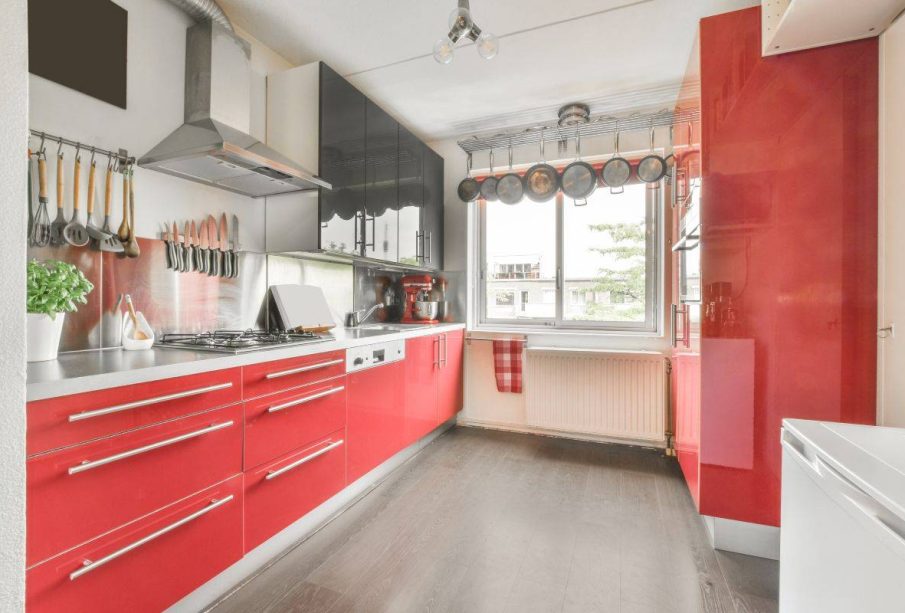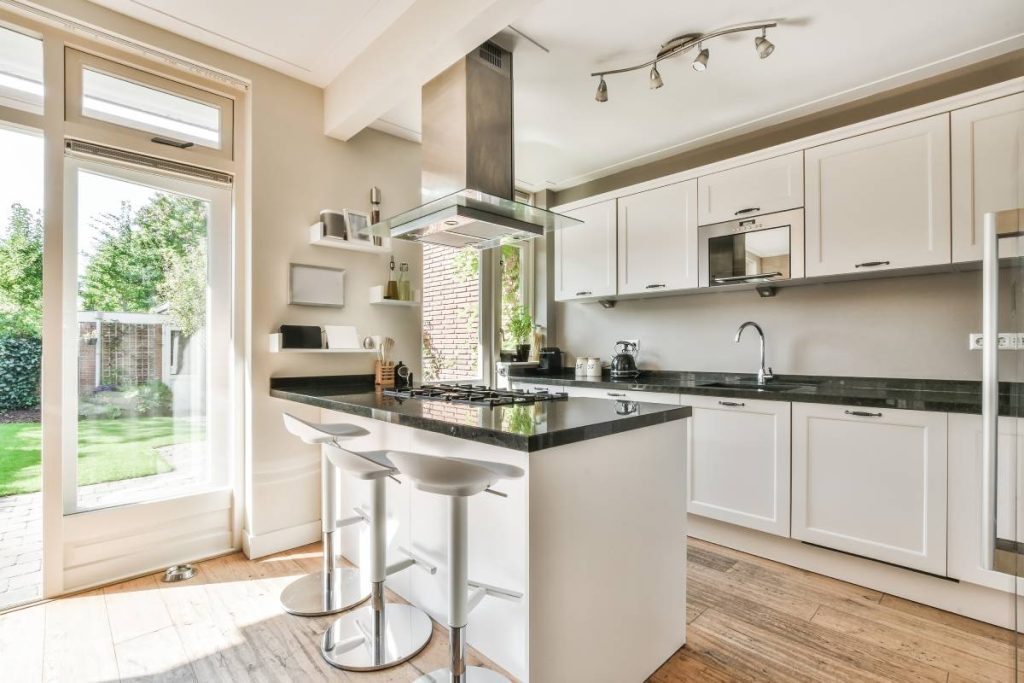How do I design my own kitchen layout? What is the best layout for a small kitchen? How to arrange kitchen without cabinets?

Designing a kitchen is a thrilling endeavor, and whether you’re working with limited space, opting for a cabinet-free approach, or simply seeking the optimal layout, the key lies in balance and practicality. In the following guide, we’ll explore three distinct kitchen design scenarios – from crafting an efficient layout in a small space to organizing a cabinet-free kitchen with creativity and flair. Each section provides practical tips in an easy-to-understand format, ensuring that regardless of your kitchen size or style, you’ll discover insightful ideas to enhance functionality and aesthetics.

How do I design my own kitchen layout?
Designing your own kitchen layout can be an exciting and rewarding endeavor, allowing you to create a space that suits your needs and reflects your personal style. Whether you’re remodeling an existing kitchen or starting from scratch, here are some easy-to-follow steps to guide you through the process.
- Assess Your Needs and Lifestyle: Begin by considering how you use your kitchen. Are you a gourmet cook, a busy parent, or someone who loves to entertain? Identifying your priorities will help you design a layout that caters to your specific needs.
- Set a Budget: Determine a budget for your kitchen project. This will help you make decisions on materials, appliances, and other elements. Stick to your budget to ensure a successful and stress-free design process.
- Measure Your Space: Accurate measurements are crucial for a successful kitchen design. Measure the dimensions of your kitchen, including doors, windows, and any architectural features. This information will be essential when planning the layout.
- Choose a Layout Style: There are several common kitchen layouts to choose from, including the galley, L-shaped, U-shaped, and open-concept designs. Select a layout that suits your space and complements your lifestyle.
- Consider the Work Triangle: The work triangle—formed by the stove, sink, and refrigerator—is a fundamental concept in kitchen design. Arrange these key elements in a triangular layout to create an efficient and functional workspace.
- Plan for Storage: Adequate storage is crucial in any kitchen. Consider the types of items you need to store, from pots and pans to pantry staples. Incorporate cabinets, drawers, and shelving to maximize storage space.
- Select Appliances: Choose appliances based on your cooking habits and available space. Consider energy-efficient options and ensure that the size and style of the appliances fit seamlessly into your chosen layout.
- Pick Your Materials: Decide on the materials for your countertops, flooring, and cabinetry. Choose durable and easy-to-maintain materials that complement your design style. Take into account factors like color, texture, and finish.
- Create Zones: Divide your kitchen into zones based on function. This may include a cooking zone, prep zone, and cleaning zone. Organizing your kitchen in this way enhances efficiency and makes daily tasks more manageable.
- Test Your Design: Before finalizing your kitchen layout, create a mock-up using tape or cardboard to outline the dimensions of cabinets and appliances. This allows you to visualize the flow of the space and make any necessary adjustments.
- Seek Professional Advice: If you’re unsure about certain aspects of your design, don’t hesitate to seek professional advice. Consult with a kitchen designer or architect to ensure that your plans are structurally sound and meet building codes.
- Review and Refine: Take the time to review your design and make any necessary refinements. Consider factors such as lighting, ventilation, and accessibility to create a well-rounded and user-friendly kitchen space.
By following these steps and keeping your needs in mind, you can design a kitchen layout that not only looks great but also functions seamlessly in your daily life. Remember, the key to a successful design is careful planning and attention to detail.

What is the best layout for a small kitchen?
Designing a small kitchen can be a challenge, but with the right layout, you can make the most of your space and create a functional and visually appealing cooking area. Here are some tips for choosing the best layout for a small kitchen in an easy-to-understand format.
- Opt for a Galley Layout: In a small kitchen, a galley layout is often the most efficient choice. This design features parallel countertops and work areas along a narrow corridor, maximizing the use of space without compromising functionality.
- Keep it Open with an L-Shaped Design: An L-shaped layout is another excellent option for a small kitchen. It utilizes two adjacent walls to create an open and airy feel. This design provides ample counter space and allows for easy movement within the kitchen.
- Consider a U-Shaped Configuration: If your small kitchen has three walls, a U-shaped layout might be the solution. This design surrounds you with countertops and cabinets on three sides, optimizing storage and creating a cozy cooking environment.
- Embrace an Island, if Space Allows: If your small kitchen has enough space in the center, consider adding a small kitchen island. This can serve multiple purposes, such as additional prep space, storage, or even a casual dining area. Ensure the island doesn’t overwhelm the room, keeping a balance between functionality and space.
- Choose Light Colors: Light colors can make a small kitchen feel more open and spacious. Opt for neutral tones like white, light gray, or soft pastels for cabinets, countertops, and walls. This creates a bright and welcoming atmosphere.
- Maximize Vertical Storage: Utilize vertical space for storage by installing tall cabinets that reach the ceiling. This prevents wasted space and provides additional room for storing kitchen essentials. Consider pull-out shelves and organizers to make the most of every inch.
- Use Multi-Functional Furniture: Look for furniture and appliances that serve multiple functions. For example, choose a dining table that can double as a prep area or a fold-down table that can be tucked away when not in use. This helps maximize the utility of your limited space.
- Install Open Shelving: Open shelving can create the illusion of more space in a small kitchen. Consider replacing some upper cabinets with open shelves to showcase dishes, glassware, or decorative items. Just be sure to keep it organized for a tidy appearance.
- Invest in Space-Saving Appliances: Opt for compact and space-saving appliances that still meet your cooking needs. Look for slim refrigerators, narrow dishwashers, and combination appliances that save counter space.
- Good Lighting is Key: Adequate lighting is essential in a small kitchen. Use a combination of task lighting, such as under-cabinet lights, and ambient lighting to brighten the space. This not only enhances visibility but also makes the kitchen feel more open.
- Keep it Clutter-Free: Clutter can make a small kitchen feel even more cramped. Keep countertops clear and only display essential items. Consider storage solutions like hooks or magnetic strips to keep utensils and cookware organized and easily accessible.
- Personalize with Small Details: Add personality to your small kitchen with small details like colorful accessories, plants, or a unique backsplash. These touches can make the space feel more inviting without overwhelming the design.
Remember, the key to a successful small kitchen layout is thoughtful planning and making the most of every inch. By incorporating these tips, you can create a stylish and efficient kitchen that suits your needs and enhances your cooking experience.

How to arrange kitchen without cabinets?
Arranging a kitchen without cabinets may seem like a challenge, but with creative solutions and thoughtful organization, you can create a functional and stylish space. Here’s a guide to help you arrange a cabinet-free kitchen in an easy-to-understand format.
- Invest in Freestanding Furniture: Without traditional cabinets, freestanding furniture becomes your kitchen’s best friend. Consider using open shelving units, standalone pantry cabinets, or movable kitchen islands. These pieces not only provide storage but also add a touch of flexibility to your kitchen layout.
- Open Shelving for Everyday Items: Embrace the beauty of open shelving for frequently used items. Install sturdy shelves on the walls to store dishes, glassware, and cookware. This not only creates easy access to essentials but also adds a decorative element to your kitchen.
- Use Baskets and Bins: To keep things organized, employ baskets and bins on your shelves or countertops. Group similar items together, such as baking ingredients or utensils, in labeled containers. This not only adds a touch of order but also makes finding what you need a breeze.
- Optimize Wall Space: Utilize your kitchen walls for storage by installing hooks, pegs, or racks. Hang pots and pans, kitchen utensils, or even herbs in small pots. This not only saves space but also adds a practical and aesthetic dimension to your kitchen.
- Consider Open Pantry Shelves: Create an open pantry concept by using adjustable shelves for storing dry goods, canned items, and small kitchen appliances. This allows you to see your inventory at a glance and makes meal preparation more efficient.
- Compact Storage Solutions: Explore compact storage solutions that fit your kitchen’s unique layout. Look for narrow shelving units, rolling carts, or stackable containers that can be easily tucked away when not in use. This flexibility ensures that your kitchen remains functional and uncluttered.
- Functional Kitchen Islands: If space permits, incorporate a kitchen island with built-in storage. Choose an island with shelves or drawers to store pots, pans, or small appliances. This not only adds counter space but also enhances the overall functionality of your kitchen.
- Install a Pot Rack: Save cabinet space by installing a hanging pot rack over your kitchen island or in another central location. This not only keeps your cookware within easy reach but also adds a decorative element to your kitchen.
- Creative Use of Furniture: Get creative with furniture that can serve dual purposes. For example, use a dresser or buffet for storing dishes, linens, or small appliances. This allows you to integrate storage seamlessly into your kitchen’s design.
- Compact Appliances: Opt for compact appliances that can fit on countertops or be easily stored when not in use. Miniature versions of common kitchen gadgets, such as blenders or coffee makers, can save space while still meeting your culinary needs.
- Minimalist Design Approach: Embrace a minimalist design philosophy to keep your kitchen visually appealing. Limit decorative items to avoid visual clutter and focus on practical, multi-functional pieces that serve your daily needs.
- Regular Decluttering: Regularly assess and declutter your kitchen to maintain an organized and efficient space. Donate or discard items you no longer use, and keep the essentials within easy reach.
Arranging a kitchen without cabinets requires a mix of creativity and practicality. By incorporating these ideas, you can design a functional and aesthetically pleasing kitchen that suits your needs and complements your lifestyle. Remember, the key is to optimize the available space while maintaining a sense of order and style.

Conclusion:
In the world of kitchen design, flexibility and innovation reign supreme. Whether you’re maximizing a small space, arranging a kitchen without cabinets, or exploring alternative layouts, the principles of thoughtful organization, creative storage solutions, and a touch of personal flair remain constant. Remember, a well-designed kitchen is not just about aesthetics; it’s about creating a space that effortlessly caters to your needs, making every culinary endeavor a joy. So, as you embark on your kitchen design journey, embrace the possibilities, tailor the ideas to your lifestyle, and transform your kitchen into a harmonious blend of form and function.
Leave a reply Cancel reply
Travel News
-
5 Practical Ways to Improve Your Financial State
March 22, 2024
Politics
-
5 Practical Ways to Improve Your Financial State
March 22, 2024









